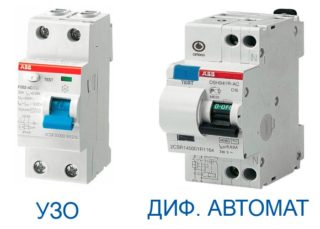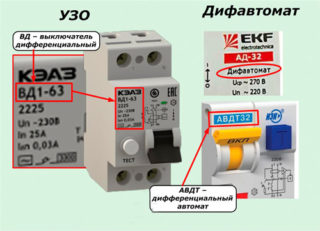More and more people are thinking about the need to protect the home electrical network from possible leaks, overloads and short circuits. Protective equipment most often has a considerable cost, but the negative influence of these factors leads to even more unpleasant consequences in the form of expensive repairs or the need to completely replace household appliances. To choose the right equipment, you need to know how it works, and also what is the difference between an RCD and a difavtomat.
Functional purpose

The RCD works if the difference between the currents in the neutral and phase wires is recorded in the network connected to it, as this indicates a leakage. This situation is fraught with serious consequences, the most dangerous of which is a person getting an electric shock if he touches the damaged equipment.
However, if you immediately turn on all electrical devices that are in the room and form a serious overload, the RCD will not work. Wiring, if no other safety options are available, will burn with this device.
With the help of an RCD, it will not be possible to ensure the safety of the electrical network from the possible occurrence of a short circuit or excessive load in it. By installing such equipment in your network, you cannot achieve protection from any emergency situations.
Differential automatic device is a special device that combines the functions of an RCD and a circuit breaker. Installing a difavtomat in the house ensures guaranteed safety of the electrical network.
The difference between a difavtomat and an RCD is that the former provides full protection against leaks, short circuits and increased loads, which cannot be achieved with an RCD.
There are several other circumstances that are important to pay attention to when choosing a particular device. First of all, this concerns the availability of free space on the DIN rail of the switchboard. The RCD, regardless of which specific model is in question, must have its own protection against short circuit or overload. In addition to it, you will have to equip a special circuit breaker, and the RCD-automatic combination requires a large amount of free space. If there is no free space for installing all this equipment on the dashboard, the question of choice disappears by itself.
If the main task is to provide protection against any troubles of large household appliances like a washing machine or a boiler, it will be enough to equip the power grid with a simple differential automatic. The main thing in this situation is to choose the right model, the technical characteristics of which will correspond to the existing load.
If it is required to provide protection against damage to the entire wiring line, which will include each outlet, lamp and all other equipment connected to the mains, an RCD and a circuit breaker can be supplied. This combination is often used as the most rational solution.If the load on the mains increases over time, the differential circuit breaker will continually cut off power indoors due to overload and will need to be replaced to be able to handle the higher rated current. When using an RCD, it is enough to simply change the circuit breaker.
The financial issue should also be taken into account. If the protection of a separate section of the wiring, which will be provided with the help of an RCD and a circuit breaker, fails for one reason or another, only one device will need to be changed. If the differential machine breaks down, it must be completely replaced, and this will be an order of magnitude more expensive.
If the RCD breaks down for some reason, the power supply in the house or apartment, if necessary, can be restored by placing a special jumper between the load and the switch. If similar problems arise with differential automatic devices, power restoration will have to be carried out only with the use of a backup automatic device.
Why devices turn off
Differential machine and RCD can be disconnected in different ways. The RCD is turned off when a leakage current has been detected in the mains. If the circuit breaker, which provides RCD protection, is turned off, this indicates a short circuit or excessive load. If the differential machine has turned off, the cause can be determined using a specialized mechanical indicator, which is equipped with most of such devices. The indicator only works when a leak occurs.
Differences in appearance
First, you should pay attention to the current marking. If only the designation of the current strength is present on the device case, we are talking about an RCD. If there is also a Latin letter, it is a differential automaton. Quite often, modern manufacturers prefer to write the full name on the case at once, but this approach is far from always found.
If the protective device is manufactured in Russia, a VD (differential switch) is prescribed in front of the digital designations. In this regard, problems with the choice most often appear when you want to buy equipment from foreign companies.
Important subtleties
One RCD can be connected to a group of several circuit breakers as one of the options for providing cost-effective protection.
Modern RCDs can have different response thresholds. If we talk about the protection of equipment that is connected, for example, to a water supply or a gas pipeline, you should pay attention to the device, which indicates a tripping current of 0.01 A. For all the others, you can use an RCD in which there will be a tripping current of 0.03 A.
Installation of circuit breakers
If, during the operation of the equipment, the appearance of a short circuit or excessive load is recorded, the circuit breaker completely de-energizes the network, but at the same time it does not work like standard circuit breakers or fuses, which are designed for an increased number of tripping cycles.
On the market, you can also find a large number of models that are triggered when other network disruptions occur (for example, a sharp drop in voltage).
Such equipment is installed inside electrical panels or cabinets, where it is fixed on special DIN rails.











